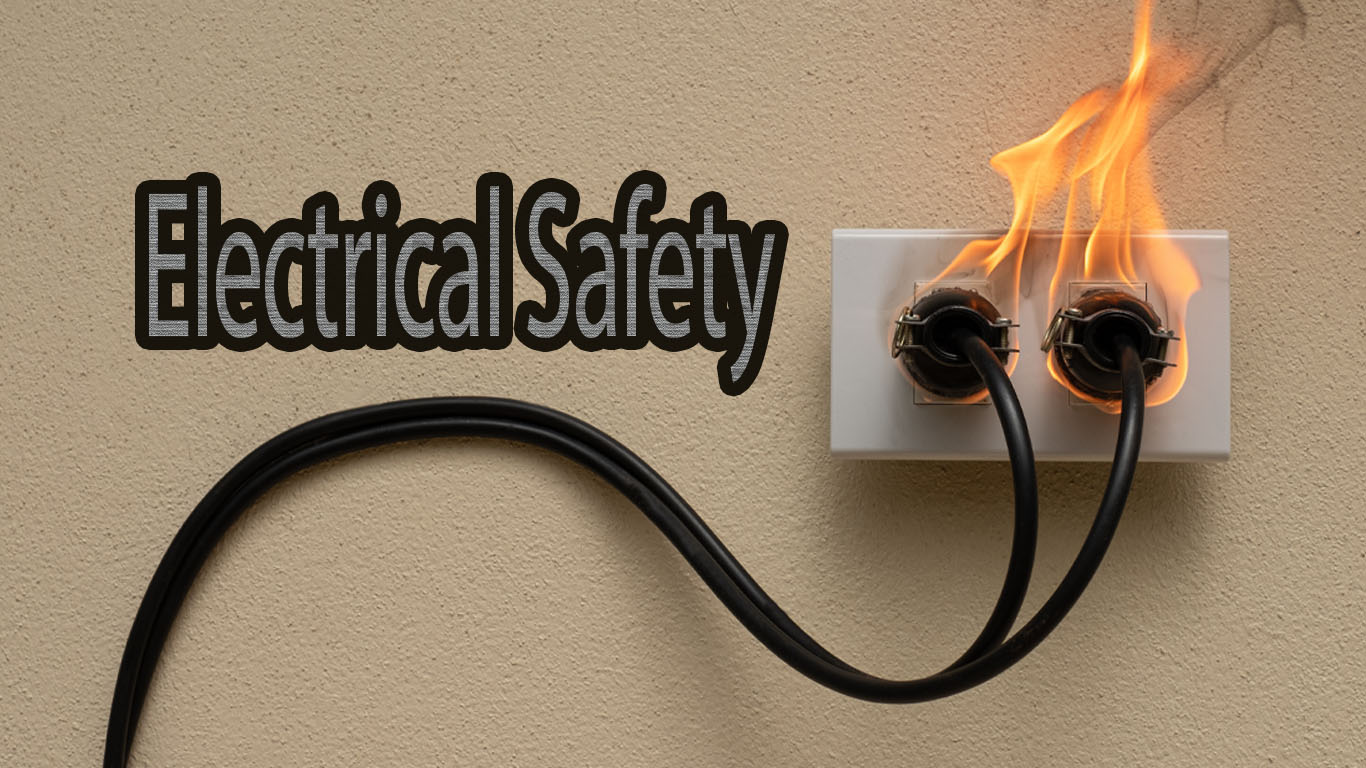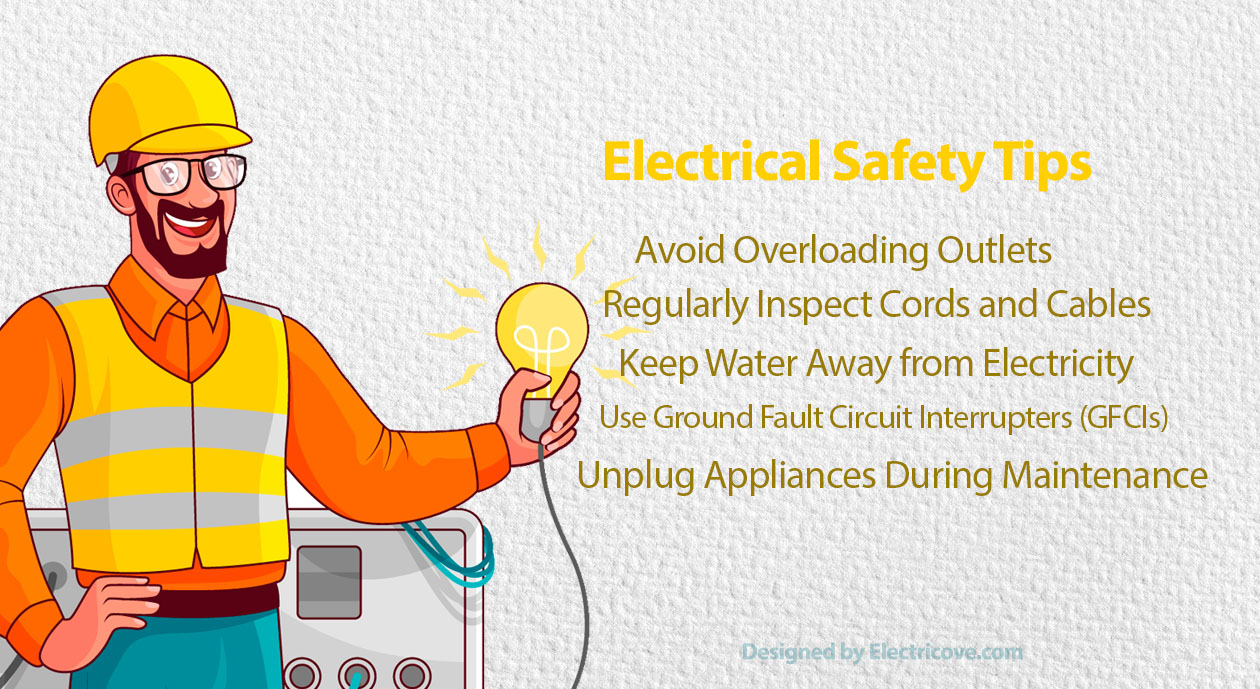Electricity safety is crucial to prevent accidents such as shocks, burns, or fires. Always handle electrical devices and outlets with caution.
Understanding electricity safety is key to maintaining a secure environment at home and work. Exposed wires, overloaded circuits, and water near electrical sources are common hazards that can lead to dangerous situations. It is essential to educate oneself and others about the proper handling of electrical equipment and the immediate environment where electricity is present.
Simple actions like unplugging appliances when not in use, using the correct wattage for light fixtures, and regularly inspecting electrical tools can significantly reduce risks. Awareness and proactive measures in electricity safety protect property and, more importantly, save lives. By respecting electricity and adhering to safety guidelines, we can harness its power without putting ourselves at risk.

The Importance Of Electricity Safety
Imagine a world without electricity. Hard. But, electricity is powerful and dangerous when not used right. We must respect it and stay safe. Safety tips and rules save lives and keep homes and schools free from harm. This post tells you why being safe with electricity matters so much.
Consequences Of Neglecting Electricity Safety
Ignoring safety can be costly, both in money and health. Wrong use of electricity may cause:
- Fires: Faulty wires can start a blaze.
- Shocks: Touching live wires hurts!
- Damage: Gadgets can break if used wrong.
People can also get hurt, or worse. It’s serious! Always follow safety steps.
Benefits Of Adhering To Safety Standards
When you play by the safety rules, good things happen. Your home stays safe. Your school stays safe. Everyone in them stays safe too. Sticking to safety means:
| Benefits | Details |
|---|---|
| No Accidents | Doing things the right way means less chance of accidents. |
| Save Money | No broken gadgets means not buying new ones often. |
| Peace of Mind | Knowing everything is safe feels good inside. |
And, you help others by setting a good example. Be smart, and follow electricity safety each day.

Common Electrical Hazards
Ensuring our homes and workplaces are safe from electrical hazards is crucial. Many common electrical risks lurk in everyday settings. They can cause fires, shocks, and other serious issues. Understanding these risks helps us prevent needless accidents and maintain a safe environment. Let’s dive into some of the most widespread electrical dangers.
Overloaded Circuits And Outlets
An overloaded circuit is often the result of too many devices drawing power at once. This can lead to overheating and potential fires. Outlets burdened with multiple adapters signify a serious risk. Be mindful of these telltale signs:
- Flickering lights when you turn on appliances
- Warm or discolored wall plates
- Frequent breaker trips or blown fuses
Prevent circuit overload by unplugging devices not in use and spreading power demands across multiple circuits.
Damaged Insulation And Exposed Wires
Insulation shields wires and keeps electricity flowing safely. Damaged insulation or bare wires could cause shocks or sparks. Look out for:
| Signs of Damage | Action to Take |
|---|---|
| Cracked or frayed wires | Turn off the power and replace |
| Bare wires | Do not touch; call an electrician |
Regularly inspect cords and cables, and replace them if they show signs of wear.
Water And Electricity: A Dangerous Mix
Electricity and water form a lethal combination. The risk of electrocution multiplies in damp environments. Always keep electrical appliances and outlets away from water. Simple tips include:
- Use covers on outdoor outlets
- Keep appliances dry and away from pools or tubs
- Immediately dry hands before handling plugs or switches
Equip bathrooms and kitchens with Ground Fault Circuit Interrupters (GFCIs) to protect against wet conditions.
Protective Measures In Homes And Workplaces
Protective Measures in Homes and Workplaces are essential to prevent electrical accidents. These measures safeguard families and employees. They reduce the risk of shocks, injuries, and fires. Let’s delve into crucial strategies for keeping everyone safe around electricity.
Proper Installation And Maintenance
Correct installation and upkeep are vital. They ensure electrical systems work safely. Always hire licensed electricians for any electrical work. They know the safety codes. Regular checks keep electrical systems in top shape. Preventive maintenance can spot issues early. This avoids potential hazards.
Using Ground Fault Circuit Interrupters (gfcis)
GFCIs protect from electrical shocks. They sense imbalances in electric flow. These devices then cut off power. GFCIs are a must in areas where water is present. Kitchens, bathrooms, and outdoor spaces must have them. Test GFCIs monthly to make sure they work right.
Childproofing Electrical Outlets
Kids are curious. To keep them safe, use tamper-resistant receptacles. These outlets prevent objects from being inserted. Plug covers also add a layer of safety. Keep cords out of reach. This stops children from pulling on them. Secure unused outlets. Educate kids about electrical safety.
Emergency Response To Electrical Accidents
Emergency response to electrical accidents saves lives and prevents further injuries. Knowing what to do in these crises is vital. Quick and correct actions can make a huge difference.
First Aid For Electric Shock Victims
Acting swiftly can help shock victims. Follow these steps:
- Ensure safety: Turn off the power source. If not possible, use a non-conductive object to move the victim away.
- Check response: Tap shoulders and ask if they’re okay.
- Call for help: Dial emergency services.
- Begin CPR: If they are unresponsive and not breathing, start CPR.
- Prevent shock: Lay them down with legs up if there’s no spine injury.
- Cover burns: Use sterile gauze or clean cloth.
- Stay until help arrives: Reassure the victim.
Handling Fires Caused By Electrical Faults
Electrical fires demand specific steps. Never use water to put out an electrical fire. Here’s what to do:
- Turn off electricity: Cut the power from the main breaker.
- Use the right extinguisher: Class C fire extinguishers are for electrical fires.
- Evacuate safely: Exit the area if the fire is too big. Close doors to contain the fire.
- Call 911: After securing safety, call for professional help.
- Stay out: Do not re-enter the area until it’s declared safe.
Regular checks on electrical installations prevent hazards. Keep smoke detectors working. A ready and informed response is key for electrical safety.
Educating The Public On Electricity Safety
Electricity is a powerful tool that lights our homes and powers our gadgets. But it can be dangerous if not handled properly. Teaching people how to use electricity safely is key. Bright ideas can keep everyone safe.
Campaigns And Public Service Announcements
Short, catchy campaigns can spark positive change. They show safety tips on TV, online, and in our neighborhoods. Everyone gets the message loud and clear:
- Don’t overload sockets
- Keep water away from electrical devices
- Unplug unused appliances
Local heroes, like firefighters, often lead these campaigns. They make safety cool and important.
Integrating Safety In School Curriculums
Schools are power stations for learning. When kids learn about electricity, they also learn how to stay safe. Let’s check what they know:
| Grade | Topics |
|---|---|
| 1-3 |
|
| 4-6 |
|
| 7-9 |
|
Learning starts with fun activities and grows into science projects. Teachers give students the tools to stay bright and safe.
Advancements In Electrical Safety Technology
Electrical safety technology advancements have revolutionized how we protect our homes and businesses from electrical hazards. Cutting-edge innovations are swiftly changing the landscape of electrical safety, ensuring that individuals and their property are safer than ever before.
Smart Homes And Automatic Shut-offs
The rise of smart homes has brought about a significant leap in electrical safety. Smart home systems provide real-time monitoring and control over household electrical systems. Users can even receive instant alerts on their smartphones if any unusual electrical activity is detected. This technology not only enhances security but also offers convenience and energy efficiency.
- Automated appliances that can be turned off remotely
- Electrical usage monitoring to spot unusual patterns
- Smart detectors that warn about faulty wiring
The Role Of Circuit Breakers And Fuses
Circuit breakers and fuses are the front-line defenders in electrical safety. They act in milliseconds to prevent electrical overloads and potential fires. Modern circuit breakers are more responsive and reliable than ever before. They safeguard our homes and businesses against the dangers of electrical surges and short circuits. Fuse technology has also seen enhancements, ensuring accurate responses to various electrical demands.
| Type | Function |
|---|---|
| Standard Circuit Breaker | Interrupts electrical flow during overloads |
| AFCI | Prevents fires by detecting arc faults |
| GFCI | Protects from electric shock near water |
Frequently Asked Questions For Electricity Safety
What Are The 5 Electrical Safety Rules?
1. Always turn off the power before conducting repairs.
2. Keep water away from electrical devices and outlets.
3. Use proper insulation to prevent electric shocks.
4. Avoid overloading outlets with too many devices.
5. Ensure all electrical equipment has proper grounding.
What Are The 5 Main Electrical Hazards?
The five main electrical hazards are shock, fires, explosions, burns, and falls due to contact with electricity.
What Are 10 Safety Precautions?
1. Always wear protective gear relevant to the task.
2. Understand and follow all safety protocols.
3. Keep emergency exits and pathways clear.
4. Store hazardous substances properly.
5. Use tools and machinery according to instructions.
6. Stay alert and avoid distractions.
7. Regularly inspect equipment for faults.
8. Practice good hygiene to prevent contamination.
9. Train properly for emergencies.
10. Report safety concerns immediately.
What Are The 3 Main Hazards Of Electricity?
The three main hazards of electricity are electric shock, electrical fires, and arc flash. Each presents serious safety risks and requires proper precautions to ensure safety.
Conclusion
Ensuring your home and workplace are safe from electrical hazards is crucial for everyone’s well-being. Adopting the tips we’ve discussed can significantly reduce risks. Remember, regular safety checks and mindful appliance usage go a long way. Stay informed and prioritize safety to keep the lights on without jeopardizing security.




